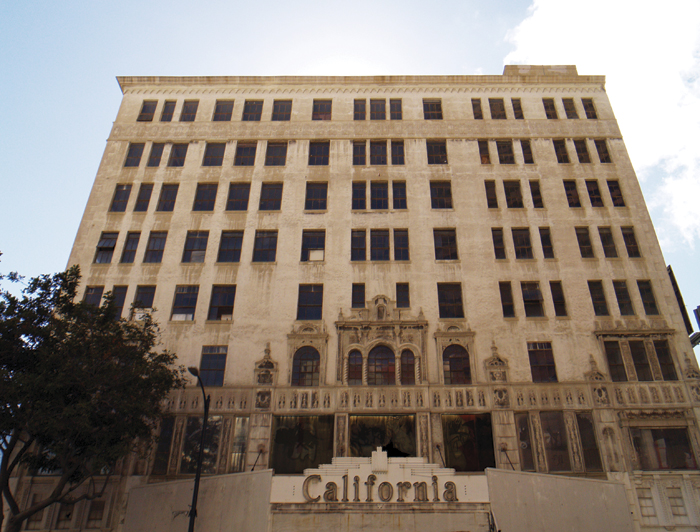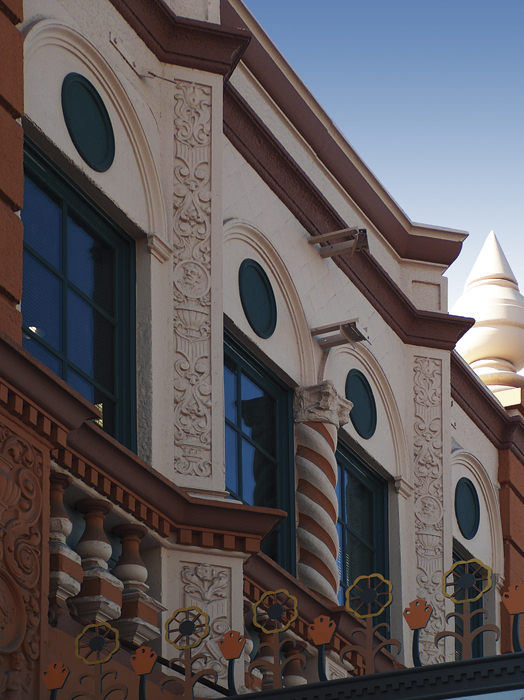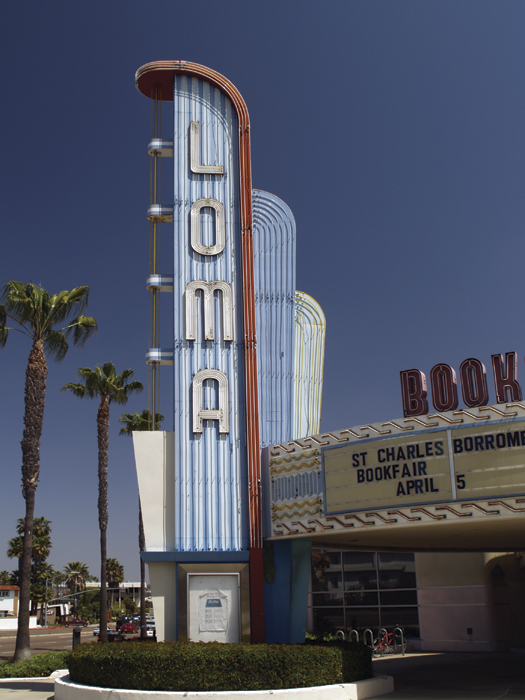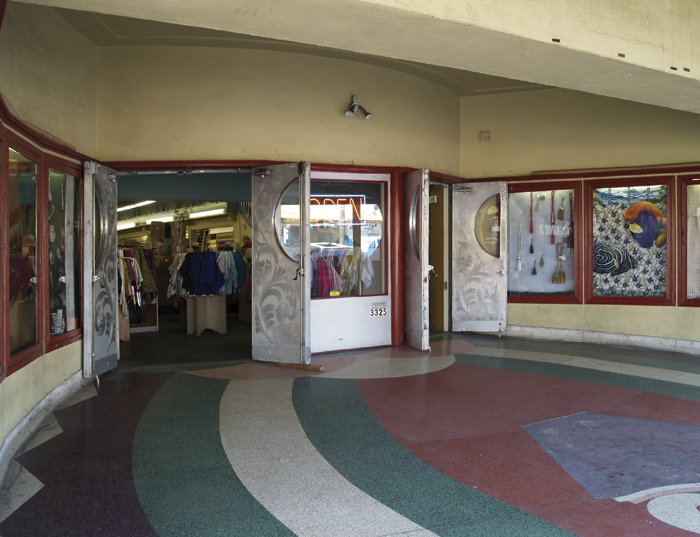|
Survivors of San Diego's Theatrical Past
By Welton Jones
One day in February, 1898, a crew of cameramen from the Thomas Edison Company shot a fragment of motion picture film showing a double-decker trolley car moving through downtown San Diego. Undoubtedly, it was projected somewhere for somebody, though details of that first local movie premiere may be lost forever.
So is the story of the first public exhibition of the art that would dominate the 20th century, however some of the earliest public movie theatres are not only known but so far, at least, still exist.
The story of American movie theatres during the last century winds through a half-dozen distinct eras: early storefronts and existing theatres to the 1920s; movie palaces with stages into the 1930s; neighborhood film-only theatres well into the 1950s; drive-in theatres in the 1950s and 60s; centrally located big-screen houses in the 60s and 70s; and, beginning in 1969, multiplexes, mostly in shopping centers.

The California (1927)
|

Detail of the upper story of the exterior of the North Park Theatre. Built in 1928, it was renovated and reopened in 2005 as a live theatre venue.
|

The Loma (1945) is an example of adaptive reuse, its spectacular blade sign and marquee is a beloved community icon.
|

The Carteri, (1924). Its original terrazzo entry is still intact providing a colorful entrance to what is now a fabric store. Sewing notions and fabric are displayed in what would have housed movie playbills.
Photos by Sandé Lollis |
A century of changes impacted the art. Talking pictures nearly killed popular live theatre. World War II brought a peak to the industry. Television wiped out B movies. Rising land costs doomed drive-ins. The concept of the art film was born, followed by a loosening of obscenity laws that inspired a small boom that brought blue movies back to some of the same storefronts used for the earliest films. Then video recordings killed that trend. The pattern was repeated all over the country.
In San Diego, the earliest movie shows were displayed either in existing legitimate (live drama) theatres like Madame Tingley's Isis Theatre (built as the Fisher Opera House in 1892 on Fourth Street between B and C), and the Grand Theatre on Fifth Street between B and C (opened in 1887 as Louis' Opera House), or in flat-floored storefronts and saloons hastily converted for the purpose.
Apparently all these latter makeshift theatres included both movies and live entertainment called vaudeville, a pastiche of music, dancing and novelty acts. Information about these establishments comes mainly from a painstaking search of old newspaper advertisements.
The earliest known houses were the Unique, the Bijou, the Novelty and the Lyric, all bunched along Fourth and Fifth Streets south of D Street (now Broadway). The oldest one still standing may be the Electridom Theater, located at 759 Fifth Street in 1907, renamed the Union Theater in 1909. The same building may also have included the Dream Theatre, opened at 755 Fifth Street August 3, 1911 and later (1926) known as the U.S. Theatre. The site is now the home of the Olé Madrid Restaurant.
Without a doubt the oldest theatre still showing movies (occasionally) is the splendid Spreckels Theatre, San Diego's premiere show business treasure. Opened in 1912, the Spreckels (known briefly during World War I as the Hippodrome) has housed grand opera, symphony orchestras, ballet, all sorts of plays and musicals, popular concerts and first-run films. Built by John D. Spreckels as part of the city's ramp up to the 1915 Panama-California Exposition, the Spreckels was the first truly modern Broadway-type theatre built west of the Mississippi River and, although San Francisco, Denver, Dallas and Los Angeles soon caught up with that distinction, the Spreckels remains one of the most beautiful and historic houses in the country.
Of the lost theatres, by far the most fascinating is the Airdrome, an outdoor theatre, which opened July 10, 1910, on the northwest corner of D Street (now Broadway) and Third Street (now Third Avenue) for a few months.
While Escondido seems to have had movies as early as 1911 with Emmott's Theatre (1911-1914) and the Midget (1913-15), the first major theatres outside downtown San Diego opened in 1913, La Jolla's Orient at 7877 Wall Street (still around as the Garden in 1924) and National City's Orpheum, at 726 National Avenue near WWII's "Little Times Square." (The city foolishly razed the Orpheum in 2001. Its sin, apparently, was its several years as a Paris Pussycat blue-movie house.)
Before 1990, when multi-screen complexes made the count meaningless, there had been at least 170 film theatres opened in San Diego County. Peak years were 1914 (10 theatres), 1930 (seven), 1950 (eight) and 1973 (nine).
The most interesting part of the record is a mixture of triumphant preservation and tragic misuse of the houses still standing in some fashion. The following is a list of theatres in the City of San Diego that were built specifically for or adapted for showing movies. In addition to the Electridom, the Dream and the Spreckels, these include:
Academy (1925) - 3721 University Avenue. A sad and abandoned victim of total neglect.
Balboa (1924) - 868 Fourth Avenue. The first downtown movie palace built for both films and live performance. The house was in continuous use until April, 1986, when it was bought by the city and rendered dark for the convenience of Horton Plaza Shopping Center. After a long battle, however, it has reopened triumphantly as a showplace of downtown live-theatre rebirth.
Cabrillo (1914) - 2171 Logan Avenue. Known by several other names: Logan Heights Theater (1917), Logan (1930), Southside (1934), and Metro (1935).
California (1917) - 665 Fifth Avenue. The name was changed to the Aztec in 1927 when the New California opened. Gutted, in use now as retail space.
Carteri (1924) - 3325 Adams Avenue. Later the Adams Avenue, it was closed in 1962. With its floor flattened, it now houses a fabric store; traces of its original festive terrazzo remain.
Casino (1913) - 647 Fifth Avenue. Gutted and its floor flattened, the building is now a chocolate shop.
Come Again (1914) - 2556 Imperial Avenue. Known as the Victory in 1930, it is still standing and used as a church. Original construction details visible from alley.
Fox(1929) - 710 B Street. The last movie palace opened just as the stock market fell. Long the downtown flagship theatre for first-run films, it spent years as a major legit roadhouse before being remodeled in 1985 as Copley Symphony Hall, home of the San Diego Symphony.
Loma (1945) - 3150 Rosecrans Blvd. A lovely neighborhood house, now a chain bookstore.
New California (1927) - 1110 Fourth Avenue. By 1930 the theater became known as simply The California, and showed films and vaudeville. It closed on April 18, 1977, after which it was used intermittently for concerts and plays. The theater also served as the temporary playhouse for the Old Globe and the San Diego Repertory Theatre in the 1980s. It is now vacant and in a condition of advanced decay through neglect.
North Park (1928) - 2895 University Avenue. A neighborhood landmark for films and vaudeville performances, it was dark for many years, then restored in 2005 as a legitimate theatre.
Panama (1913) - 516 Fifth Avenue. The Building has been completely re-bricked, its original clay tile visible in rear alley.
Ramona (1922) - 3010 University Avenue. Now a retail store but original details still remain inside.
Rivoli (1923) - 656 Fifth Avenue. Across the street from the Casino and Aztec, this lovely small house was known by many names: Diana (1933), Savoy Penthouse (1974), Savoy Cinema X (1980) - and Bijou (1984). The floor has been flattened for restaurant use, the tragedy and comedy masks still visible on the façade, a bit forlorn.
Strand (1930) - 4952 Newport Avenue, Ocean Beach. One of the last single-screen, neighborhood theatre holdouts, its floor was flattened in the 1990s for retail.
There are several other structures still standing that were either built as or adapted in later years into movie theatres. Some of them, such as the Ken in Kensington, are still operating. Others, like Vista's Avo, have become live-theatre houses. Many of the wide-screen houses in Mission Valley and elsewhere now hold retail stores and retain no trace of their history; there is little of ongoing historical interest.
|
|
MORE FROM THIS ISSUE
From the Editor
The Balboa Theatre - Anatomy of a Restoration
The Balboa Theatre - An 18-year redevelopment battle
Survivors of San Diego's Theatrical Past
Professional Theater Comes to San Diego
Googie: An Architectural Link to San Diego's Midcentury Culture
North Park's Neon
A General Plan of Destruction
Unearthing Long-Buried Whaley House Cistern
Preservation Community
Reflections
Lost San Diego
Strength in Numbers
Donations 2007-2008
Advertisements
DOWNLOAD full magazine as pdf (16mb)
|







